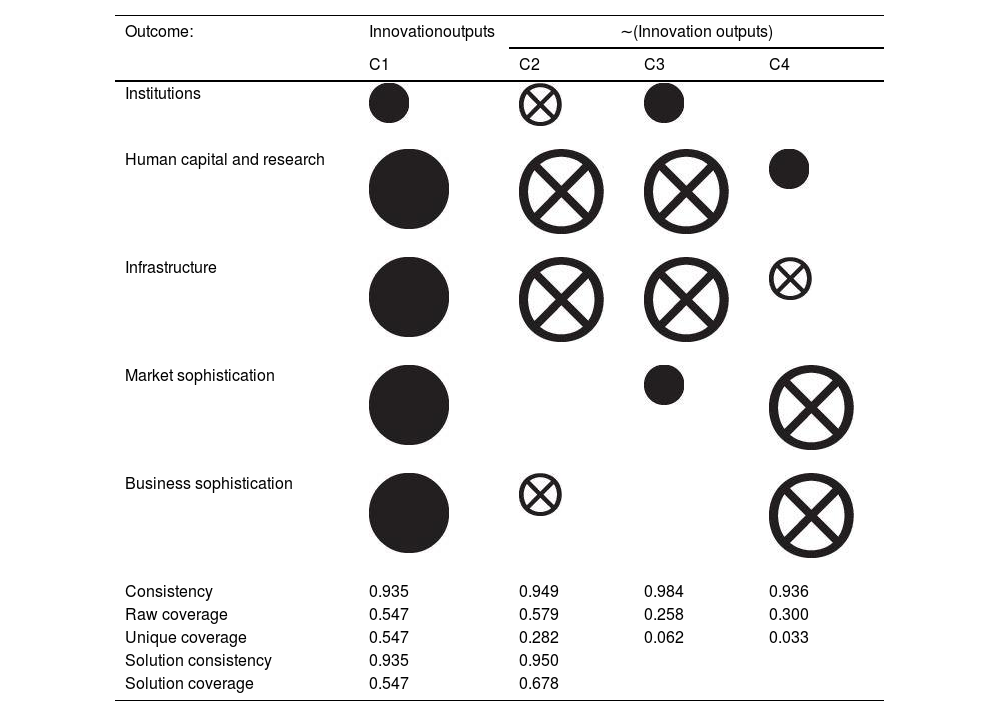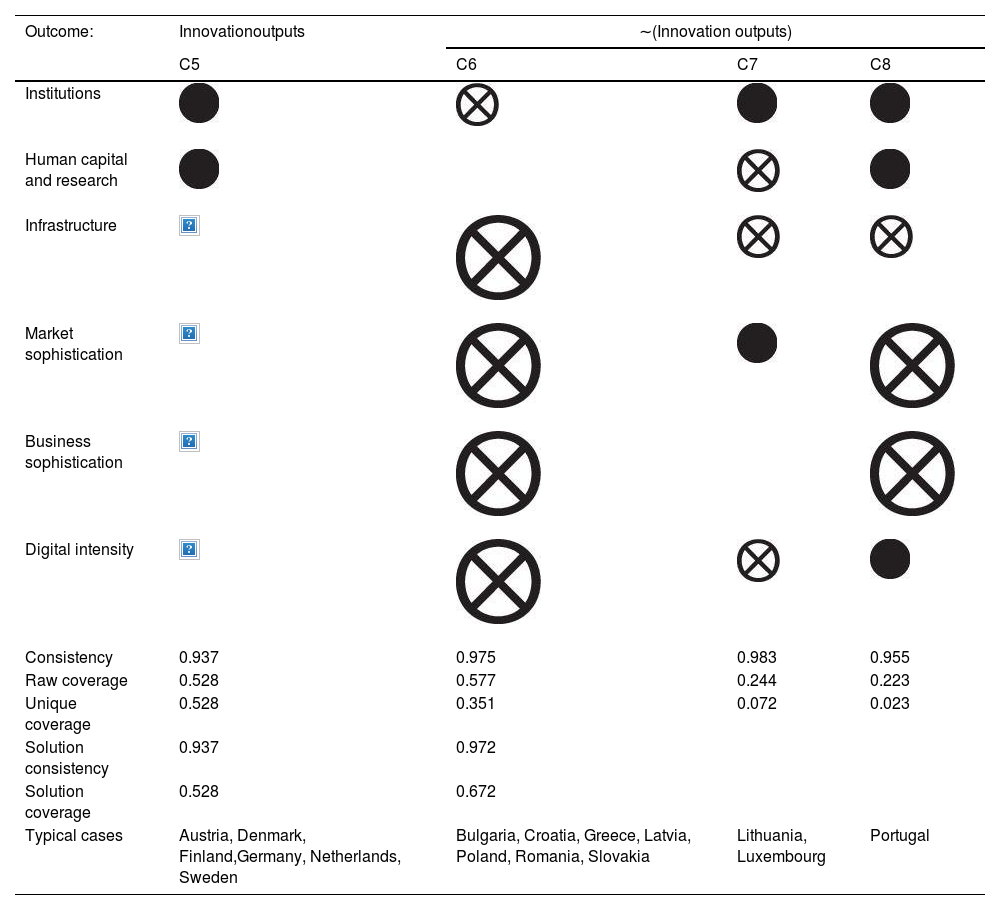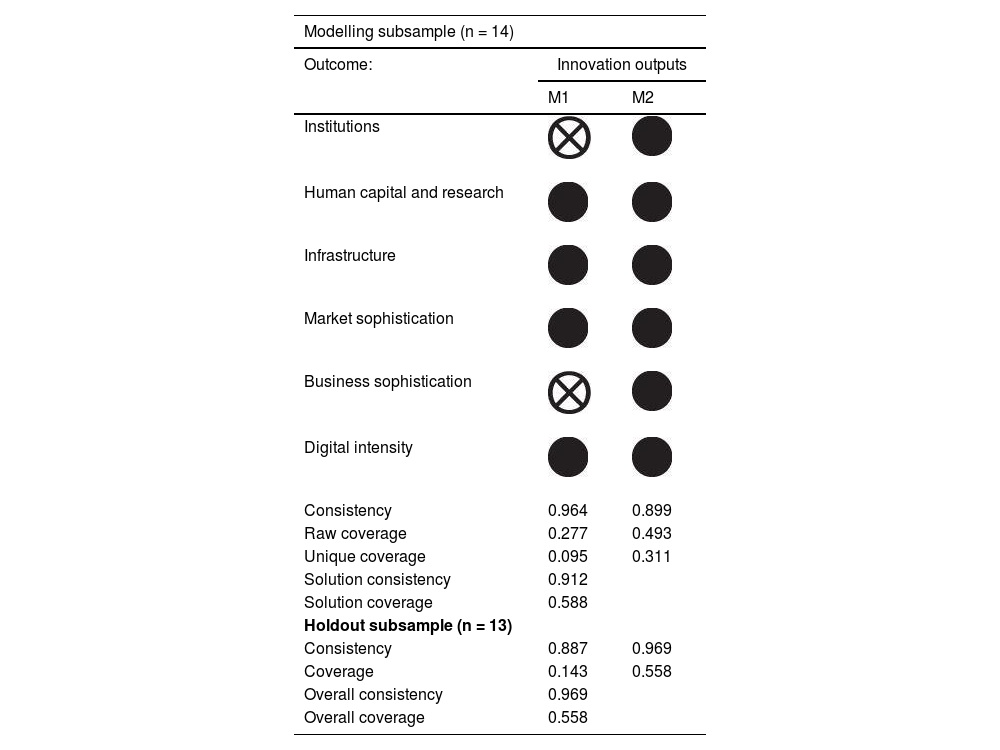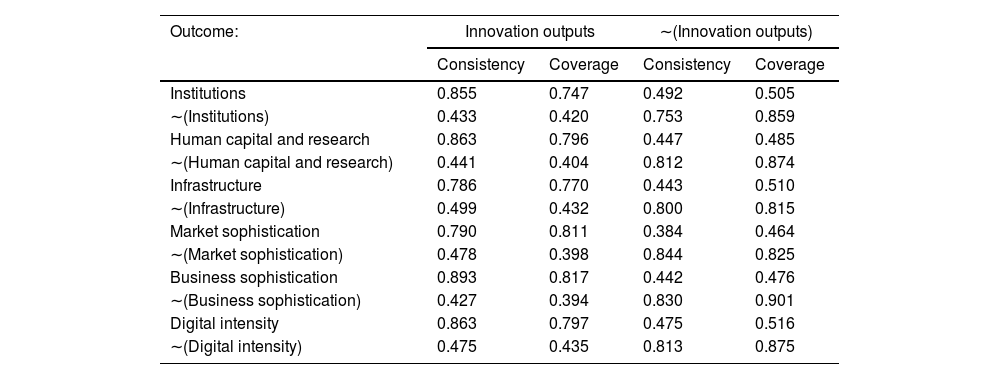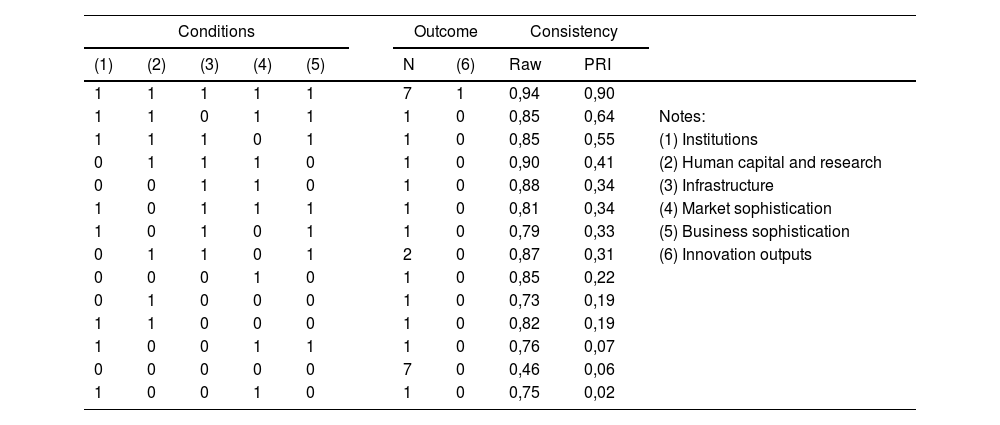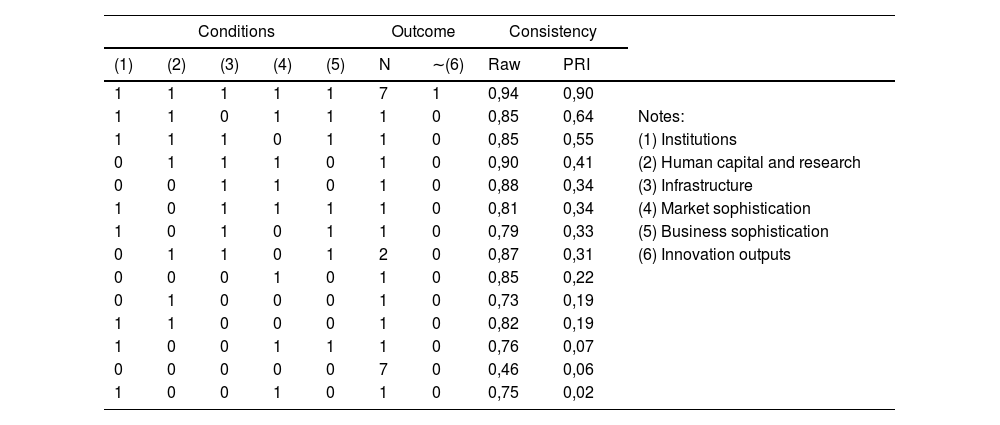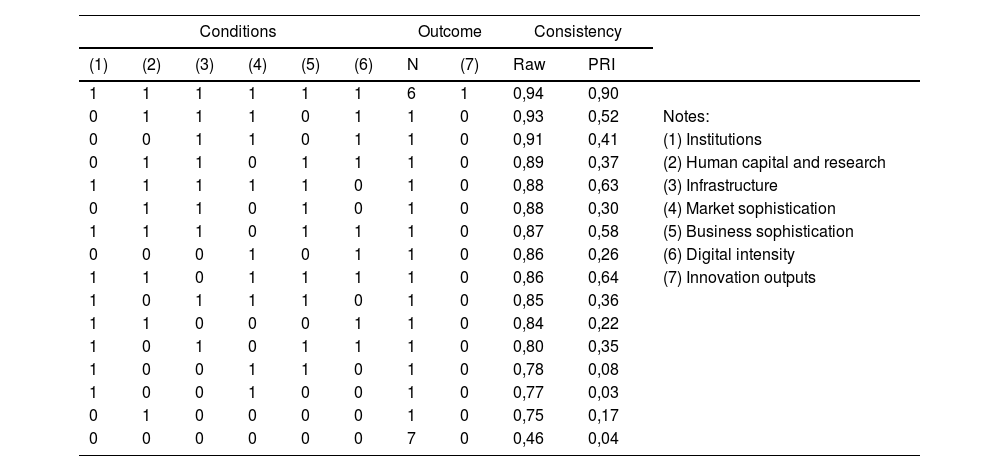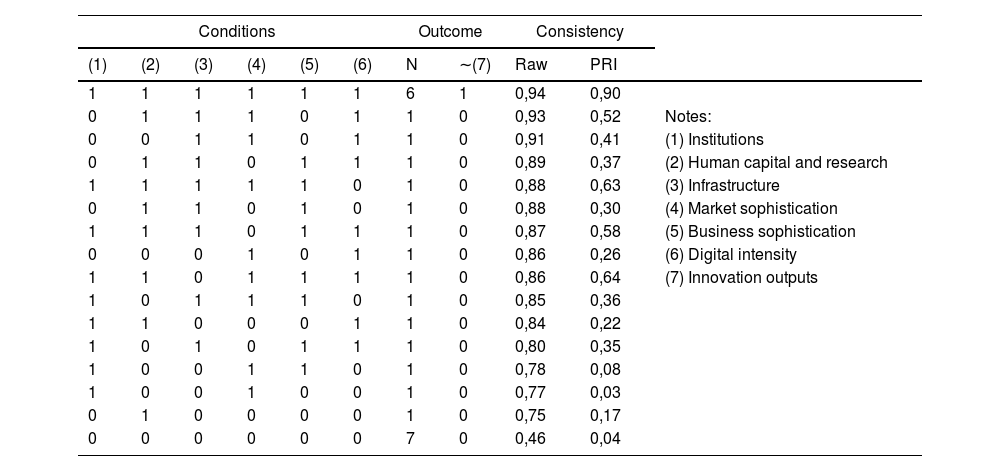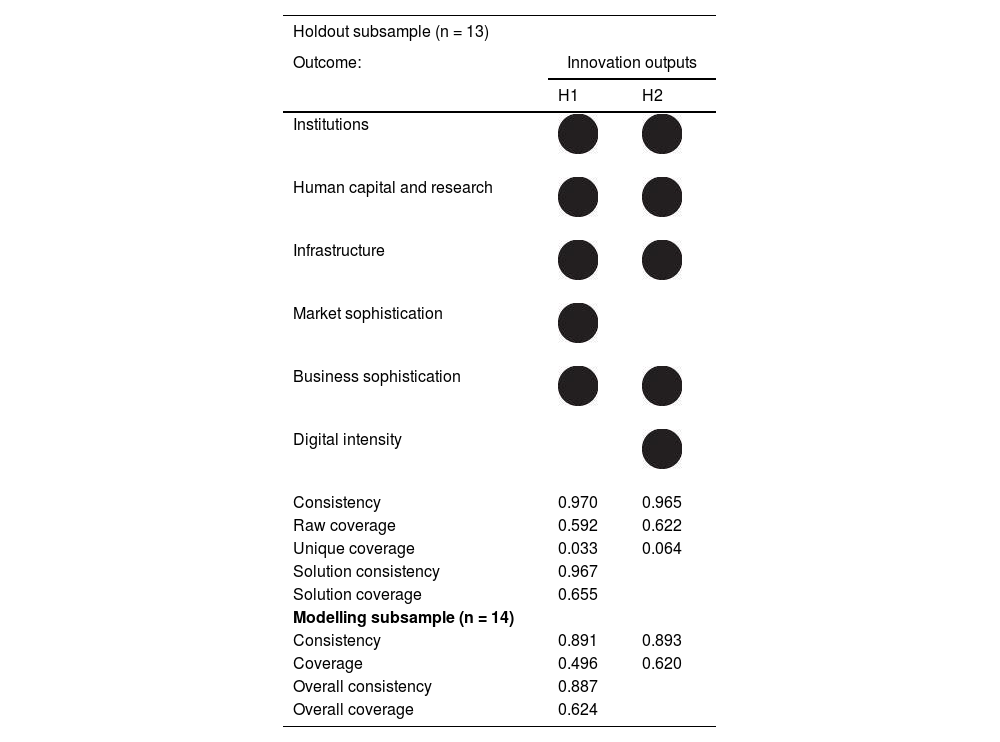Digital transformation is changing the innovation landscape, not only of firms but also at the macro level. This study aims to analyse how configurations of European Union countries’ innovation inputs that lead to innovation outputs are affected by the levels of national digital transformation. A novel configurational moderation approach is adopted to assess the impact of digital transformation on the 27 EU countries’ national systems of innovation (NSI). Results showed that the presence of all innovation inputs is a sufficient configuration for the presence of high innovation outputs, while three different configurations were found to be sufficient for its absence. The configurational moderation analysis revealed that digital transformation effectively moderates the arrangement of innovation inputs leading to the presence of high innovation outputs, where the human capital and research pillar loses its importance. The results of this study can be understood as benchmarks, against which less innovative countries may compare and develop their NSI. They also shed light on the specific configurations followed by each EU country in achieving innovation outputs, which could be an input for Union-based policies directed at the development of concrete innovation pillars in specific Member States. Furthermore, findings enlighten international business managers about the strengths and weaknesses of EU countries’ NSI, which may aid them in their internationalisation decisions.
Digital transformation is shaping the innovation landscape and the configurations of countries' innovation systems (Panori et al., 2021). The phenomenon has gathered substantial attention in the fields of information systems (Vial, 2019), management (Chen et al., 2024; Hanelt et al., 2021), innovation studies (Appio et al., 2024; Nambisan et al., 2019), and multidisciplinary research (Verhoef et al., 2021), for it has a significant potential to introduce innovation and enhance the competitiveness of firms (Fleury et al., 2024; Nambisan et al., 2019; Zhou et al., 2023). Recently, however, scholars began paying attention to the impacts of digital transformation on levels other than the firm, proposing that transformations are being felt at the institutional and societal levels (Dąbrowska et al., 2022; Hinings et al., 2018). For instance, e-government is increasingly a reality for multiple services provided by central or local administrations (Khan & Park, 2013; Rey-Moreno et al., 2018), transforming the way citizens engage in public initiatives.
The literature on national systems of innovation (NSI) argues that innovation in firms does not happen in isolation, but rather from the interactions with other actors (e.g., suppliers, customers, competitors, industry regulators, universities, government) and within the boundaries of the national institutional context (Edquist, 2006; Lundvall, 2007). This argument implies that innovation is dependent not only on individual efforts by firms and other actors, but also on the nature of interactions that are established between them, as well as with the existing institutional setting. Thus, changes in the way research and development (R&D) is conducted and interactions within the system are established are likely to cause the rate and direction of innovation to shift as well.
Digital transformation in this context entails a restructuring of innovation processes, both within and between actors in the system (Ciarli et al., 2021). Empirically, it has been recognised that the integration of digital technologies affects the innovation processes of firms (Escoz Barragan et al., 2024; Yu et al., 2024; Zhou et al., 2023), yet macro-level analyses of the influence of digital transformation on NSI are still scarce. For instance, Galindo-Martín et al. (2023) found that combinations of digital transformation levels, investment in talent, and venture capital availability were linked to countries’ entrepreneurship levels, highlighting the importance of a favourable environment in which actors may benefit from digital technologies. Assuming a different perspective, Ionescu et al. (2022) discovered that institutional and business sophistication drivers positively influence the levels of digital transformation of European countries. Conversely, Rîndașu et al. (2023) found a positive impact of digital adoption levels on national innovation outputs. Taken together, these studies suggest the existence of interactions between digital transformation and NSI, but the way such interactions are established still eludes our grasp. This leads us to the following research question: Considering that countries’ NSI involve an interplay among the various innovation inputs that lead to innovation outputs, how does digital transformation shape such a relationship?
Consequently, the present study aims to assess how configurations of countries’ innovation inputs that lead to innovation outputs are affected by the levels of national digital transformation. Drawing on a configurational perspective of NSI and digital transformation literature, we argue that the ability of countries to translate innovation inputs into innovation outputs is contingent on the level of digital transformation. We adopt a novel, two-stage fuzzy-set Qualitative Comparative Analysis (fsQCA) approach (Ma et al., 2024) to assess how European Union (EU) countries' digital transformation moderates the configurational relationship between innovation inputs and innovation outputs.
The remainder of this paper is structured as follows. The next section (Section 2) reviews the literature and advances the propositions of this study. Then, the methodology is described in Section 3 along with a detailed explanation of the two-stage fsQCA approach. In Section 4 results are presented and discussed in Section 5. Lastly, Section 6 concludes and highlights the study's contributions, implications, limitations and avenues for future research.
Theoretical backgroundDigital transformation can be defined as “a socioeconomic change across individuals, organizations, ecosystems, and societies that is shaped by the adoption and utilization of digital technologies” (Dąbrowska et al., 2022, p. 932). According to Verhoef et al. (2021), digital transformation has fundamentally changed the behaviour and expectations of consumers, exerted pressure on traditional businesses, and disrupted multiple markets. From the point of view of the firm, integration of digital technologies has a significant impact on innovation processes. For instance, Escoz Barragan et al. (2024) found that an advanced stage of digital transformation increased the likelihood of radical innovations in SMEs. Likewise, Chen et al. (2024) reported a significant impact of digital transformation on the innovation capabilities of firms. These results imply that firms’ integration of digital technologies not only facilitates the development of innovation but also enhances firms’ capabilities to produce such innovations. Even though it has been recognised that the adoption of digital technologies affects firms’ innovation processes (Escoz Barragan et al., 2024; Nambisan et al., 2019; Zhou et al., 2023), considerably less attention has been given to its impacts on the transformation of innovation systems (Dąbrowska et al., 2022; Reischauer, 2018).
The relationship between innovation inputs and outputsDrawing from the NSI approach, innovation systems are defined as “all important economic, social, political, organizational, institutional, and other factors that influence the development, diffusion, and use of innovations” (Edquist, 2006, p.182). This definition recognises that countries need to possess particular combinations of factors for innovation to occur, which might have different degrees of importance for different countries’ innovation outputs. We extend Edquist's (2006) definition by assuming that the different factors can be considered innovation inputs, representing “investments” in NSI; whereas innovation outputs can be understood as the immediate results of such “investments”, in terms of the creation, diffusion, and use of innovations. With this extension, we intend to draw the definition of innovation systems closer to the innovation input-output framework (Godin, 2007), so that meaningful relationships can be established between innovation inputs and the corresponding results. We do, however, refrain from establishing the link between NSI and societal-level outcomes, such as economic growth, income inequalities, or others since the focus of this study lies on national innovation processes.
There is a rich empirical literature dealing with the determinants of innovation outputs, where a particular emphasis is given to the configurational nature of such relationships (Crespo & Crespo, 2016; Ding, 2022; Duarte & Carvalho, 2024a; Khedhaouria & Thurik, 2017; Tekic & Tekic, 2021; Wang et al., 2021; Yu & Huarng, 2023). This strand of research mainly concludes that no innovation input by itself is sufficient for achieving high levels of innovation. Rather, its effects on innovation outputs happen when they combine in paths, or configurations, that become sufficient for high innovation outputs to occur, which is exemplified by the Venn diagram in Fig. 1 and the respective arrow conducing to innovation outputs.
However, there is a lack of consensus about the specific configurations of innovation inputs that are more favourable for innovation to occur (Crespo & Crespo, 2016; Duarte & Carvalho, 2024a; Wang et al., 2021), which highlights the diverse ways in which countries can successfully develop their NSI (Cantwell, 2006). Hence, we advance with the following proposition.
Proposition 1: Several equifinal combinations of innovation inputs exist that are sufficient for high innovation outputs.
The moderating role of digital transformationEmpirical research dealing with the interplay between digital transformation and NSI is rather sparse, yet evidence of this interplay exists. For example, Rîndașu et al. (2023) examined the impact of EU countries’ levels of digitalisation on innovation outputs. The authors found that the digital transformation of EU countries positively influences their innovation outputs, albeit with a moderate effect size and partially mediated by skills adequacy. This finding links with the EU Commission's expectation for digital and innovation development of its member-states (Decision (EU) 2022/2481), emphasising the importance of digital transformation for innovation. Another example is that of Ionescu et al. (2022), who studied how digitalisation levels are affected by various innovation inputs. Particularly, the authors found that the institutional framework and the sophistication of businesses are the best predictors of digital transformation, suggesting that corporate adoption of digital technologies might benefit from well-integrated institutions across several social domains.
Taken together, these studies suggest that digital transformation can conduce to higher innovation outputs and that innovation inputs can influence digital transformation, suggesting an interaction between digital transformation and innovation inputs leading to innovation outputs. Yet, little is known about how digital transformation may shape countries' NSI, as proposed in Fig. 1 with the moderating effect of digital transformation on the relationship between configurations of innovation inputs and innovation outputs.
Given that different countries rely on different paths, or combinations of innovation inputs to achieve innovation outputs (Crespo & Crespo, 2016; Huarng & Yu, 2022; Khedhaouria & Thurik, 2017), digital transformation is likely to work as a contingency factor affecting how countries develop their paths to higher innovation outputs, leading us to the following proposition.
Proposition 2: Combinations of innovation inputs leading to high innovation outputs suffer a moderating effect of digital transformation.
MethodsThe fsQCA method is based on set theory (Ragin, 2008) since many arguments in the social sciences can be outlined in terms of relationships between sets (Schneider & Wagemann, 2012). For instance, it can be argued that digital transformation levels are closely related to countries’ innovation; this can be framed as almost all countries with high levels of digital transformation are innovative. In terms of set relations, we could argue that the set of highly digitally-transformed countries is mostly contained in the set of innovative countries, and the fact that there are countries with low levels of digital transformation that are also innovative does not undermine the claim, for the argument claims that digital transformation is sufficient for innovation.
Relationships between sets are analysed in terms of necessity and sufficiency (Schneider & Wagemann, 2012). A condition is considered necessary for the outcome set if it is fully contained in the condition set (Dul, 2016). Regarding sufficiency, a condition is considered sufficient for the outcome if its set is contained in the outcome set (Ragin, 2008). Boolean logic is used to analyse if combinations of conditions are sufficient for an outcome.
FsQCA involves several steps. After data collection and cleaning, conditions are calibrated, which allows to establish the degree of membership of each case in each condition: fully in, fully out, and neither fully in nor fully out (Ragin, 2008). Fuzzy-set calibration entails the assignment of a value between 0 and 1 to represent the degree of membership in each condition, which is typically based on three anchor points: full membership (1), full non-membership (0), and the point of maximum ambiguity (0.5).
After calibration, a truth table is constructed depicting all possible combinations of conditions that can be sufficient for the outcome (Schneider & Wagemann, 2012). The resulting matrix lays down the set of conditions (in columns) and every possible combination of conditions in rows. Conditions can be either present or absent, resulting in a total of 2k rows, where k is the number of causal conditions in the model. Due to a phenomenon called limited diversity, not all rows have empirical representation (logical remainders) (Schneider & Wagemann, 2012).
Two decisions must be made once the truth table is constructed: what is the frequency threshold, and which combinations are considered sufficient for the outcome. The first decision is related to the relevance of causal combinations. By setting a threshold of 1, only empirically observed combinations are considered in the analysis, which is a reasonable threshold for small-n samples (Ragin, 2008). For the second decision, consistency scores and proportional reduction in inconsistency (PRI) values allow the researcher to distinguish combinations of conditions that are subsets of the outcome from those that are not (Schneider & Wagemann, 2012). A consistency below 0.75 is considered to indicate substantial inconsistency (Ragin, 2008), and recommendations indicate higher values (Greckhamer et al., 2018; Pappas & Woodside, 2021). Simultaneously, PRI values below 0.5 indicate substantial inconsistency, for the same configuration could be sufficient for both the presence and the absence of the outcome (Greckhamer et al., 2018). Hence, recommendations indicate that the PRI values should be high and close to the consistency threshold (Pappas & Woodside, 2021).
The truth tables are analysed through Boolean algebra, which logically minimises the sufficient configurations (see Schneider and Wagemann (2012), chapter 4 for a detailed explanation). The analysis returns three solutions (Ragin, 2008): a complex solution that makes no simplifying assumptions, a parsimonious solution that makes all simplifying assumptions, and an intermediate solution that makes only some simplifying assumptions. Results usually follow from the intermediate solution, since the complex solution tends to be too complex to be interpreted in a meaningful way. However, parsimonious and intermediate solutions are used simultaneously to identify core and peripheral conditions (Fiss, 2011).
The fsQCA method described above allows us to explicitly model complex causality (Misangyi et al., 2017) by considering that: the effect of a single condition only exists in combination with other conditions (conjunctural causation), different combinations of conditions can lead to the same outcome (equifinality), and the combinations of conditions explaining the presence of an outcome are not necessarily the exact opposite of those explaining its absence (causal asymmetry) (Schneider & Wagemann, 2012).
We present next the sample and data used in this study (Section 3.1) and the considerations involving the calibration of conditions (Section 3.2). Since this study intends to uncover the configurational moderating role of digital transformation on the relationship between combinations of innovation inputs and innovation outputs, the two-stage fsQCA approach (Ma et al., 2024) and its requirements are described in Section 3.3.
Sample and dataOur sample included all 27 EU Member States. Although EU Member States’ levels of digitalisation and innovation are somewhat homogenous compared with countries in other regions of the world, there are wide disparities between them, as Southern and Eastern countries still lag behind most Central and Nordic EU countries. Nevertheless, innovation and digital transformation have recently become central to the European Commission and Member States (Decision (EU) 2022/2481).
Secondary data used in this study was gathered from the European Commission's Digital Decade DESI database and WIPO's Global Innovation Index (GII). There are three reasons why we used GII data to proxy for innovation: 1) It is considered a valid indicator of national innovation activities (Gault & Soete, 2022), 2) It explicitly distinguishes innovation inputs from innovation outputs, and 3) Its structure approximates the elements that define NSI (Alcorta & Peres, 1998). Digital Decade DESI data refers to the digital transformation of businesses. Data gathered from both databases report to 2023, the latest year available.
CalibrationCalibration in set-theoretic methods involves establishing the degree of membership each case has in each condition by defining three anchor points (Ragin, 2008): full membership (1), cross-over point (0.5), and full non-membership (0). Good practices in fsQCA (Fiss, 2011; Misangyi et al., 2017) recommend that thresholds for anchor points be set on theoretical grounds where available. However, when theoretical threshold values are not established, calibration based on the sample's percentiles is the preferred method (Fiss, 2011; Khedhaouria & Thurik, 2017). In this study, we used the latter calibration method (10th, 50th, and 90th percentiles for full non-membership, cross-over point, and full membership, respectively) due to a lack of theoretical knowledge regarding the conditions analysed. Furthermore, given the fact that membership scores of exactly 0.5 are dropped in the construction of truth tables, we added a constant of 0.001 to all calibrate conditions with membership scores below one (Fiss, 2011).
Outcome: innovation outputsGII's knowledge and technology outputs pillar is the outcome of interest in this study. This pillar's scores ranged between 0 and 100, with higher scores indicating better performance. This pillar encompasses three sub-pillars (knowledge creation, impact, and diffusion) that are based on indicators such as patents, scientific articles, software spending, high-tech manufacturing, high-tech exports, or intellectual property receipts (WIPO, 2023). Previous country-level studies used the GII's innovation output subindex (Ding, 2022; Rîndașu et al., 2023), which includes the knowledge and technology outputs and creative outputs pillars. In this study, the innovation output measure used reflects the definition advanced earlier in Section 2.1 as the immediate results of “investments” in NSI, in terms of the creation, diffusion, and use of innovations.
Causal conditions: innovation inputsThe five innovation input pillars of GII (institutions, human capital and research, infrastructure, market sophistication, and business sophistication) are used in this study as causal conditions leading to innovation outputs, which are commonly used in the literature (Ionescu et al., 2022; Khedhaouria & Thurik, 2017; Wang et al., 2021). Each input pillar is composed of three sub-pillars that aggregate several indicators, such as government effectiveness and rule of law (institutions pillar), expenditure on education and gross expenditure on R&D (human capital and research pillar), ICT access and environmental performance (infrastructure pillar), domestic credit to private sector and domestic market scale (market sophistication pillar), and formal training in firm and university-industry collaboration (business sophistication pillar) (WIPO, 2023). Scores of each pillar range from 0 to 100 and higher scores indicate better performance.
Moderator condition: digital intensityThe European Commission's Digital Decade DESI database is a reliable source of digital transformation indicators in EU countries and various studies have used them to assess its relationship with sustainability (Dabbous et al., 2024; Zoppelletto & Bullini Orlandi, 2022) and innovation (Ionescu et al., 2022; Marti & Puertas, 2023; Rîndașu et al., 2023). To measure digital transformation in EU countries, we used the DESI indicator of digital intensity, which assesses the percentage of small and medium-sized enterprises (SMEs) with at least a basic level of digital intensity. Given a list of 12 selected technologies that are used by SMEs, to achieve a basic level of digital intensity a firm must use at least four (European Commission, 2023). This indicator is used by the EU to assess member states' adherence to digital targets, particularly “more than 90 % of Union SMEs reach at least a basic level of digital intensity” (Decision (EU) 2022/2481). Since there was only a single point of reference, we were compelled to calibrate this condition following the percentile method.
Descriptive statistics and calibration thresholds for all conditions are shown in Table 1.
Descriptive statistics and calibration thresholds.
| N | Mean | S.D. | Min | Max | Calibrationthresholds | |
|---|---|---|---|---|---|---|
| Innovation outputs | 27 | 41.64 | 9.59 | 28.03 | 63.45 | 31.52/39.38/59.39 |
| Institutions | 27 | 65.64 | 11.97 | 47.13 | 85.44 | 47.89/64.26/82.58 |
| Human capital and research | 27 | 45.79 | 9.32 | 29.07 | 62.68 | 33.38/44.58/60.19 |
| Infrastructure | 27 | 57.36 | 4.93 | 48.45 | 69.18 | 51.48/56.84/66.04 |
| Market sophistication | 27 | 44.47 | 9.88 | 30.41 | 67.64 | 33.38/44.34/60.05 |
| Business sophistication | 27 | 48.07 | 12.01 | 28.68 | 75.81 | 31.77/47.19/64.21 |
| Digital intensity | 27 | 67.64 | 12.34 | 41.20 | 89.50 | 50.80/67.30/87.28 |
Research with moderation analyses almost exclusively relies on regression-based methods (Aiken & West, 1991; Hair et al., 2019). One of the main limitations of these methods is their inability to test moderation when the studied relationship is of a configurational nature (Pappas & Woodside, 2021). This study uses a two-stage configurational moderation approach developed by Ma et al. (2024) in a fsQCA setting, a method previously used in the literature (Duarte & Carvalho, 2024b). As its name suggests, it validates a moderator in a fsQCA analysis through two stages. First, a sufficient conditions analysis for the intended outcome is performed using the causal conditions alone, which in our case involved the construction of a truth table with the five innovation inputs. In the second stage, the proposed moderator is added to the truth table and results can be compared. To identify a moderator in the second stage of analysis, the solution obtained in the first stage should not change dramatically. Hence, Ma et al. (2024), pp., 772–773 established three requirements for a moderator to be identified: first, “there should be no changes in the causal factors within the causal recipe from the first to the second stage”; second, "there should be at least one moderated configuration that has change(s) of core/peripheral conditions (i.e., from core to peripheral or from peripheral to core) between the two stages”; and third, “in at least one of the moderated configurations, the moderator should be a core presence condition”.
Even though the focus of this study is on the configurations leading to the presence of innovation outputs, we also conducted the analysis for the absence of innovation outputs to avoid common pitfalls in QCA (Schneider & Wagemann, 2012). We follow the convention of core/peripheral conditions proposed by Fiss (2011), which states that a core condition is one that is both part of the parsimonious and the intermediate solution, and a peripheral condition is one that exists only in the intermediate solution. The notation used in tables is as follows: black circles (“●”) indicate the presence of a condition, crossed out circles (“⨂”) indicate its absence, blank spaces indicate a situation in which the causal condition may be either present or absent (also termed “don't care” condition), large circles indicate core conditions and small circles indicate peripheral conditions.
ResultsPreliminary analysesBefore conducting fsQCA analyses, good practices recommend performing a contrarian case analysis to assess the existence of cases that contradict the main effects, which would be excluded from the outcome of a traditional regression-based analysis (Greckhamer et al., 2018; Pappas & Woodside, 2021). Table 2 shows the summary statistics of the association between each causal condition and the outcome, as well as the number of cases that are contrary to the expected direction of the relationships. According to this analysis, a non-trivial number of cases contradict the main effects, supporting the need to perform a configurational analysis. In keeping with good practices (Pappas & Woodside, 2021), a necessary conditions analysis was also performed (Table A.1), revealing that no single condition is necessary for the presence or absence of high innovation outputs.
Summary of contrarian case analysis.
| Condition | Kendall's tau-c (p-value) | Number of contrarian cases (%) |
|---|---|---|
| Institutions | 0.518 (<0.001) | 3 (11.1 %) |
| Human capital and research | 0.645 (<0.001) | 1 (3.7 %) |
| Infrastructure | 0.453 (<0.001) | 2 (7.4 %) |
| Market sophistication | 0.528 (<0.001) | 2 (7.4 %) |
| Business sophistication | 0.641 (<0.001) | 3 (7.4 %) |
| Digital intensity | 0.610 (<0.001) | 3 (11.1 %) |
Kendall's tau-c test assesses the degree of association between each condition and innovation outputs.
The first stage of the configurational moderation analysis involved the construction of truth tables for both the presence and the absence of the outcome, where the five input pillars (institutions, human capital and research, infrastructure, market sophistication, and business sophistication) entered as causal conditions. The resulting truth tables included 25 = 32 rows, corresponding to all possible combinations for the presence or absence of the five causal conditions. Once completed, logical remainders (i.e., combinations of conditions without empirical observations) were removed (Pappas & Woodside, 2021; Ragin, 2008), which we managed by setting a frequency threshold of 1. We established the presence of the outcome (presence or absence of high innovation outputs) in combinations (rows) where raw consistency was above 0.85, which is an accepted threshold in the literature (Greckhamer et al., 2018). Additionally, we considered a PRI (proportional reduction in inconsistency) score above 0.75, since it is recommended to be high and close to the consistency threshold (Greckhamer et al., 2018; Pappas & Woodside, 2021). The resulting truth tables can be seen in Tables A.2 and A.3.
Table 3 shows the solutions obtained in the first stage, revealing one configuration that consistently leads to the presence of high innovation outputs (consistency=0.935, coverage=0.547), and three configurations for the absence of high innovation outputs (consistency=0.950, coverage=0.678). These results do not support Proposition 1, which proposed several equifinal combinations of innovation inputs leading to high innovation outputs. Since our sample focused on EU countries, it is likely that they harness the full capabilities of their NSI, which might not be the case in other countries where specific combinations of innovation inputs are associated with high innovation outputs (Khedhaouria & Thurik, 2017).
Sufficient conditions analysis.
| Outcome: | Innovationoutputs | ∼(Innovation outputs) | ||
|---|---|---|---|---|
| C1 | C2 | C3 | C4 | |
| Institutions | ||||
| Human capital and research | ||||
| Infrastructure | ||||
| Market sophistication | ||||
| Business sophistication | ||||
| Consistency | 0.935 | 0.949 | 0.984 | 0.936 |
| Raw coverage | 0.547 | 0.579 | 0.258 | 0.300 |
| Unique coverage | 0.547 | 0.282 | 0.062 | 0.033 |
| Solution consistency | 0.935 | 0.950 | ||
| Solution coverage | 0.547 | 0.678 | ||
∼ denotes the absence of a condition.
Configuration C1 indicates that the conjunction of all five innovation inputs is sufficient for the outcome, where the institutions pillar is the only condition considered to be peripheral. Regarding the absence of high innovation outputs, configurations C2 and C3 are neutral permutations around the absence of human capital and research and infrastructure. C2 has the highest unique coverage (0.28), meaning that 28 % of cases are uniquely explained by this path, and includes the absence of institutions and business sophistication as peripheral conditions. Configuration C3, on the other hand, includes the presence of institutions and market sophistication as peripheral conditions. Configuration C4 shows that the absence of market sophistication and business sophistication are core conditions for the absence of high innovation outputs, where the presence of human capital and research and the presence of infrastructure are peripheral conditions.
In the second stage, two new truth tables were constructed with the five innovation input pillars plus digital intensity, resulting in tables with 26 = 64 rows (Tables A.4 and A.5). The same frequency and consistency/PRI thresholds were used. Table 4 provides the solutions for the second stage. The requirements for identifying digital intensity as a moderator condition are met for the presence of high innovation outputs: first, the single configuration obtained in the first stage remained unchanged (i.e., all five innovation inputs are present), second, human capital and research pillar changed from core to peripheral condition, and third, digital intensity appeared as a core condition in the solution. This result supports Proposition 2. Nevertheless, the requirements were not met for the absence of high innovation outputs, indicating that digital intensity only moderates the configurational relationship between innovation inputs and the presence of high innovation outputs.
Moderating impacts of digital intensity.
| Outcome: | Innovationoutputs | ∼(Innovation outputs) | ||
|---|---|---|---|---|
| C5 | C6 | C7 | C8 | |
| Institutions | ||||
| Human capital and research | ||||
| Infrastructure | ||||
| Market sophistication | ||||
| Business sophistication | ||||
| Digital intensity | ||||
| Consistency | 0.937 | 0.975 | 0.983 | 0.955 |
| Raw coverage | 0.528 | 0.577 | 0.244 | 0.223 |
| Unique coverage | 0.528 | 0.351 | 0.072 | 0.023 |
| Solution consistency | 0.937 | 0.972 | ||
| Solution coverage | 0.528 | 0.672 | ||
| Typical cases | Austria, Denmark, Finland,Germany, Netherlands, Sweden | Bulgaria, Croatia, Greece, Latvia, Poland, Romania, Slovakia | Lithuania, Luxembourg | Portugal |
∼ denotes the absence of a condition.
Configuration C5 shows that when digital intensity is high, the human capital and research pillar, albeit still present, becomes a peripheral condition, hence losing its importance in the configuration that explains high innovation outputs in EU countries. Additionally, infrastructure, market sophistication, business sophistication, and digital intensity were identified as core conditions, and institutions remained a peripheral condition. An overall consistency of 0.937 reveals that the empirical evidence supports a strong relationship between the solution and the outcome. Moreover, overall coverage (0.528) shows that a substantial proportion of cases are explained by the solution. EU countries that are considered typical cases covered by this configuration include Germany, Austria, Netherlands, and Nordic EU countries, for they presented membership scores in configuration C5 and the outcome above 0.5 (Schneider & Wagemann, 2012).
Regarding the absence of high innovation outputs, configuration C6 included the absence of infrastructure, market sophistication, business sophistication, and digital intensity as core conditions, where the absence of institutions is a peripheral condition. Typical cases with this configuration include Greece, Latvia, and most Eastern EU countries. Configuration C7 is representative of Luxembourg and Lithuania, where the absence of human capital and research, infrastructure, and digital intensity, and the presence of institutions and market sophistication are all peripheral conditions leading to the absence of high innovation outputs. Lastly, C8 shows that the absence of market sophistication and business sophistication are core conditions for the absence of high innovation outputs, whereas the absence of infrastructure and the presence of institutions, human capital and research, and digital intensity are peripheral conditions. Portugal is the only typical case represented by configuration C8.
Robustness of findingsTo attest the validity of the results and their sensitivity to threshold changes, we conducted several analyses (Greckhamer et al., 2018; Pappas & Woodside, 2021). First, we tested the predictive validity (for detailed procedures see Pappas and Woodside (2021)) of our model to see how well it predicted innovation outputs in different samples. Thus, two random subsamples were created (modelling and holdout) from the full sample, containing a similar number of cases. A sufficient conditions analysis was then performed for each subsample holding the frequency and consistency/PRI cut-offs from the main analysis. Table 5 reveals that the holdout subsample consistently predicts the solution obtained from the modelling subsample, and both overall consistency and coverage values are close to those of the main analysis (Table A.6 shows the predictive validity test of the modelling subsample with the solution obtained with the holdout subsample). These results highlight a good predictive validity of our model.
Predictive validity testing.
| Modelling subsample (n = 14) | ||
|---|---|---|
| Outcome: | Innovation outputs | |
| M1 | M2 | |
| Institutions | ||
| Human capital and research | ||
| Infrastructure | ||
| Market sophistication | ||
| Business sophistication | ||
| Digital intensity | ||
| Consistency | 0.964 | 0.899 |
| Raw coverage | 0.277 | 0.493 |
| Unique coverage | 0.095 | 0.311 |
| Solution consistency | 0.912 | |
| Solution coverage | 0.588 | |
| Holdout subsample (n = 13) | ||
| Consistency | 0.887 | 0.969 |
| Coverage | 0.143 | 0.558 |
| Overall consistency | 0.969 | |
| Overall coverage | 0.558 | |
Black circles indicate the presence of a condition, and circles with “⊗” indicate its absence. Blank spaces indicate “don't care” conditions.
We also assessed the robustness of our results when calibration anchor points and consistency thresholds changed (Greckhamer et al., 2018). These analyses were performed only for the presence of high innovation outputs. Frequency threshold changes were not conducted because using a frequency of 2 or higher would imply the removal of more than 20 % of cases (Ragin, 2008). Thus, we performed two analyses, considering consistency/PRI thresholds of 0.9/0.8 in one and 0.8/0.7 in another. Regarding changes in calibration anchor points, two other analyses were conducted: one with a dataset calibrated with percentiles 5/50/95, and the other with percentiles 15/50/85. Table 6 provides a summary of robustness analyses. Concerning the main findings, no changes in the solution were observed. Consistency and coverage values obtained were similar to those of the main results. Evidence confers robustness to our initial results, supporting a moderating role of digital intensity on the relationship between innovation inputs and outputs.
Discussion of resultsThe purpose of this study was to analyse how configurations of countries’ innovation inputs leading to innovation outputs are affected by digital transformation levels. The study was motivated by a gap in the digital transformation literature. As Dąbrowska et al. (2022) noted, the majority of studies tend to focus on digital transformation at the organisational level, while its national impact is often overlooked. We addressed this gap by focusing on how digital transformation shapes countries' NSI.
Our first proposition stated that there are several equifinal combinations of innovation inputs that are sufficient for high innovation outputs. The results did not support this proposition, for only one configuration was found to be sufficient for high innovation outputs. This finding is in line with that of Yu and Huarng (2023), who found that a single combination of all five input pillars led to high innovation outputs in recent years. Nevertheless, our results challenge other studies that found several equifinal configurations of innovation inputs that are sufficient for innovation outputs in high-income countries (Crespo & Crespo, 2016; Wang et al., 2021). Khedhaouria and Thurik (2017), on the other hand, despite finding two equifinal configurations leading to high innovation outputs, discovered that only one combination of the five innovation input pillars was sufficient for very high innovation outputs. This suggests that only countries with well-developed, highly diversified NSI attain very high levels of innovation outputs.
The second proposition stated that combinations of innovation inputs leading to high innovation outputs suffer a moderating effect of digital transformation. The results of our configurational moderation analysis revealed that configurations of EU countries’ innovation inputs that are conducive to high innovation outputs change in the presence of high digital intensity, and such change is reflected in the loss of importance of the human capital and research pillar. This is perhaps the most surprising finding, which should not be understood as a loss of jobs due to investments in digital technologies (Balsmeier & Woerter, 2019) because its presence is still part of a sufficient combination of conditions leading to high innovation outputs. Furthermore, the human capital and research pillar primarily reflects the level of education of the workforce and investments made in R&D, which, according to our results, becomes a contributing condition supporting the central roles of digital intensity, infrastructure, and market and business sophistication. This finding could be explained by the fact that digital skills are failing to catch up with digital technological advancements (Greenan & Napolitano, 2024), leading to a shortage of skilled labour (Skare et al., 2023). Attention should be given to this issue since literature has shown that innovation in European SMEs is increasingly anchored on employees’ digital skills (Scuotto et al., 2021).
Even though digital intensity was not identified as a moderator when combinations of innovation inputs led to the absence of high innovation outputs, some findings are worth discussing. First, results reveal the causal asymmetry tenet of fsQCA by identifying configurations leading to the absence of high innovation outputs that are not the exact opposite of the configuration leading to the presence of the outcome. Second, three configurations were obtained for the absence of high innovation outputs in EU countries. An important point of clarification is that the absence of high innovation outputs does not necessarily correspond to low innovation outputs, it rather identifies the group of countries with membership scores below 0.5 in the set of high innovation outputs (Ragin, 2008; Schneider & Wagemann, 2012). That being said, our results offer a benchmark against which the EU and national governments could guide Member States' policies towards increasing their innovation levels. Moreover, since different countries possess different configurations, tailored solutions could be developed for specific member states. In the case of Portugal, for instance, infrastructure and market and business sophistication pillars should be the principal focus of improvement.
ConclusionOverall, this paper helped us to understand the role of digital transformation in EU countries’ NSI, which we have found to be of central importance for achieving high innovation outputs. Results revealed that highly diverse NSI, where high levels of innovation inputs are present, is sufficient for attaining innovation outputs in EU countries. Furthermore, digital transformation was shown to influence how combinations of innovation inputs translate into innovation outputs. Hence, policy decision-makers intent on raising their countries’ innovation output levels should acknowledge the need for a well-developed NSI and improve the digital transformation of their businesses.
Contributions and implicationsThis study provides the following contributions. First, we respond to scholars’ concerns about the absence of research on the impacts of digital transformation at the country level (Dąbrowska et al., 2022). Even though it is recognised that digital technologies influence several societal phenomena (Ganju et al., 2016; Majchrzak et al., 2016), their influence on countries’ NSI is still underexplored. Thus, by analysing how digital transformation impacts NSI, this study provides evidence of the transformative role of digital transformation in countries' ability to convert innovation inputs into innovation outputs.
Second, while previous studies uncovered the national innovation inputs that matter most for achieving high levels of digital transformation (Ionescu et al., 2022), and described how digital transformation impacts innovation outputs directly and indirectly through digital skills (Ciarli et al., 2021; Rîndașu et al., 2023), their adopted perspectives prevented a systemic, configurational analysis of how innovation inputs combine with each other to produce innovation outputs. Hence, this study not only adopts a configurational perspective, but also positions digital transformation as a boundary condition that shapes how EU countries arrange their innovation inputs to attain innovation outputs. By adopting both a configurational and contingency approach for analysing the role of digital transformation in countries' NSI, this study established a richer and “thick” understanding of this phenomenon (Jackson & Deeg, 2019).
Policy implications of this study are straightforward since the solution obtained that leads to the presence of high innovation outputs can be considered a benchmark, against which other countries can compare and develop their NSIs accordingly. Furthermore, by knowing the specific configuration followed by each country, tailored policies can be developed towards specific innovation pillars in need of improvement. Moreover, owing to the fact that human capital and research could be lagging behind the introduction of new digital technologies, such as big data or generative artificial intelligence, Union-based recommendations should be made to promote the necessary development of digital skills in every EU Member State. Implications for businesses may also be derived, particularly those devoted to internationalisation within the EU. Our results educate business managers about the specific configuration of EU countries’ NSI, revealing the strengths and weaknesses of their innovation inputs.
Limitations and future research directionsA limitation of this study is that data was gathered for a single point in time, which prevents us from acquiring deeper knowledge of the evolution of the configurational moderation found in our results. Future studies might find it fruitful to assess whether the configurations obtained here remain stable across time, particularly when exogenous shocks, such as the COVID-19 pandemic, occur. Furthermore, a single innovation measure–the Global Innovation Index–was used in this study. Other measures, such as the European Commission's European Innovation Scoreboard, could be better adjusted to EU Member States, yet it lacks the input-output property, which is a relevant characteristic for analysing the innovation performance of countries (Edquist et al., 2018).
FundingThis work was supported by FCT – Fundação para a Ciência e a Tecnologia, I.P., Project UIDB/05037/2020 with DOI 10.54499/UIDB/05037/2020. Marcelo Duarte also acknowledges funding from FCT – Fundação para a Ciência e a Tecnologia, Project UI/BD/150977/2021 with DOI 10.54499/UI/BD/150977/2021. The funding source was not involved in the study design, data collection, analysis and interpretation, in the writing of the report, nor in the decision to submit the article for publication.
CRediT authorship contribution statementMarcelo Pereira Duarte: Writing – review & editing, Writing – original draft, Visualization, Validation, Software, Methodology, Investigation, Funding acquisition, Formal analysis, Data curation, Conceptualization. Fernando Manuel Pereira de Oliveira Carvalho: Writing – review & editing, Validation, Supervision, Project administration, Investigation, Funding acquisition, Conceptualization.
Necessary conditions analysis.
| Outcome: | Innovation outputs | ∼(Innovation outputs) | ||
|---|---|---|---|---|
| Consistency | Coverage | Consistency | Coverage | |
| Institutions | 0.855 | 0.747 | 0.492 | 0.505 |
| ∼(Institutions) | 0.433 | 0.420 | 0.753 | 0.859 |
| Human capital and research | 0.863 | 0.796 | 0.447 | 0.485 |
| ∼(Human capital and research) | 0.441 | 0.404 | 0.812 | 0.874 |
| Infrastructure | 0.786 | 0.770 | 0.443 | 0.510 |
| ∼(Infrastructure) | 0.499 | 0.432 | 0.800 | 0.815 |
| Market sophistication | 0.790 | 0.811 | 0.384 | 0.464 |
| ∼(Market sophistication) | 0.478 | 0.398 | 0.844 | 0.825 |
| Business sophistication | 0.893 | 0.817 | 0.442 | 0.476 |
| ∼(Business sophistication) | 0.427 | 0.394 | 0.830 | 0.901 |
| Digital intensity | 0.863 | 0.797 | 0.475 | 0.516 |
| ∼(Digital intensity) | 0.475 | 0.435 | 0.813 | 0.875 |
∼ denotes the absence of a condition.
First-stage truth table (presence of innovation outputs).
| Conditions | Outcome | Consistency | ||||||||
|---|---|---|---|---|---|---|---|---|---|---|
| (1) | (2) | (3) | (4) | (5) | N | (6) | Raw | PRI | ||
| 1 | 1 | 1 | 1 | 1 | 7 | 1 | 0,94 | 0,90 | ||
| 1 | 1 | 0 | 1 | 1 | 1 | 0 | 0,85 | 0,64 | Notes: | |
| 1 | 1 | 1 | 0 | 1 | 1 | 0 | 0,85 | 0,55 | (1) Institutions | |
| 0 | 1 | 1 | 1 | 0 | 1 | 0 | 0,90 | 0,41 | (2) Human capital and research | |
| 0 | 0 | 1 | 1 | 0 | 1 | 0 | 0,88 | 0,34 | (3) Infrastructure | |
| 1 | 0 | 1 | 1 | 1 | 1 | 0 | 0,81 | 0,34 | (4) Market sophistication | |
| 1 | 0 | 1 | 0 | 1 | 1 | 0 | 0,79 | 0,33 | (5) Business sophistication | |
| 0 | 1 | 1 | 0 | 1 | 2 | 0 | 0,87 | 0,31 | (6) Innovation outputs | |
| 0 | 0 | 0 | 1 | 0 | 1 | 0 | 0,85 | 0,22 | ||
| 0 | 1 | 0 | 0 | 0 | 1 | 0 | 0,73 | 0,19 | ||
| 1 | 1 | 0 | 0 | 0 | 1 | 0 | 0,82 | 0,19 | ||
| 1 | 0 | 0 | 1 | 1 | 1 | 0 | 0,76 | 0,07 | ||
| 0 | 0 | 0 | 0 | 0 | 7 | 0 | 0,46 | 0,06 | ||
| 1 | 0 | 0 | 1 | 0 | 1 | 0 | 0,75 | 0,02 | ||
First-stage truth table (absence of innovation outputs).
| Conditions | Outcome | Consistency | |||||||
|---|---|---|---|---|---|---|---|---|---|
| (1) | (2) | (3) | (4) | (5) | N | ∼(6) | Raw | PRI | |
| 1 | 1 | 1 | 1 | 1 | 7 | 1 | 0,94 | 0,90 | |
| 1 | 1 | 0 | 1 | 1 | 1 | 0 | 0,85 | 0,64 | Notes: |
| 1 | 1 | 1 | 0 | 1 | 1 | 0 | 0,85 | 0,55 | (1) Institutions |
| 0 | 1 | 1 | 1 | 0 | 1 | 0 | 0,90 | 0,41 | (2) Human capital and research |
| 0 | 0 | 1 | 1 | 0 | 1 | 0 | 0,88 | 0,34 | (3) Infrastructure |
| 1 | 0 | 1 | 1 | 1 | 1 | 0 | 0,81 | 0,34 | (4) Market sophistication |
| 1 | 0 | 1 | 0 | 1 | 1 | 0 | 0,79 | 0,33 | (5) Business sophistication |
| 0 | 1 | 1 | 0 | 1 | 2 | 0 | 0,87 | 0,31 | (6) Innovation outputs |
| 0 | 0 | 0 | 1 | 0 | 1 | 0 | 0,85 | 0,22 | |
| 0 | 1 | 0 | 0 | 0 | 1 | 0 | 0,73 | 0,19 | |
| 1 | 1 | 0 | 0 | 0 | 1 | 0 | 0,82 | 0,19 | |
| 1 | 0 | 0 | 1 | 1 | 1 | 0 | 0,76 | 0,07 | |
| 0 | 0 | 0 | 0 | 0 | 7 | 0 | 0,46 | 0,06 | |
| 1 | 0 | 0 | 1 | 0 | 1 | 0 | 0,75 | 0,02 | |
∼ denotes the absence of a condition.
Second-stage truth table (presence of innovation outputs).
| Conditions | Outcome | Consistency | ||||||||
|---|---|---|---|---|---|---|---|---|---|---|
| (1) | (2) | (3) | (4) | (5) | (6) | N | (7) | Raw | PRI | |
| 1 | 1 | 1 | 1 | 1 | 1 | 6 | 1 | 0,94 | 0,90 | |
| 0 | 1 | 1 | 1 | 0 | 1 | 1 | 0 | 0,93 | 0,52 | Notes: |
| 0 | 0 | 1 | 1 | 0 | 1 | 1 | 0 | 0,91 | 0,41 | (1) Institutions |
| 0 | 1 | 1 | 0 | 1 | 1 | 1 | 0 | 0,89 | 0,37 | (2) Human capital and research |
| 1 | 1 | 1 | 1 | 1 | 0 | 1 | 0 | 0,88 | 0,63 | (3) Infrastructure |
| 0 | 1 | 1 | 0 | 1 | 0 | 1 | 0 | 0,88 | 0,30 | (4) Market sophistication |
| 1 | 1 | 1 | 0 | 1 | 1 | 1 | 0 | 0,87 | 0,58 | (5) Business sophistication |
| 0 | 0 | 0 | 1 | 0 | 1 | 1 | 0 | 0,86 | 0,26 | (6) Digital intensity |
| 1 | 1 | 0 | 1 | 1 | 1 | 1 | 0 | 0,86 | 0,64 | (7) Innovation outputs |
| 1 | 0 | 1 | 1 | 1 | 0 | 1 | 0 | 0,85 | 0,36 | |
| 1 | 1 | 0 | 0 | 0 | 1 | 1 | 0 | 0,84 | 0,22 | |
| 1 | 0 | 1 | 0 | 1 | 1 | 1 | 0 | 0,80 | 0,35 | |
| 1 | 0 | 0 | 1 | 1 | 0 | 1 | 0 | 0,78 | 0,08 | |
| 1 | 0 | 0 | 1 | 0 | 0 | 1 | 0 | 0,77 | 0,03 | |
| 0 | 1 | 0 | 0 | 0 | 0 | 1 | 0 | 0,75 | 0,17 | |
| 0 | 0 | 0 | 0 | 0 | 0 | 7 | 0 | 0,46 | 0,04 | |
Second-stage truth table (absence of innovation outputs).
| Conditions | Outcome | Consistency | ||||||||
|---|---|---|---|---|---|---|---|---|---|---|
| (1) | (2) | (3) | (4) | (5) | (6) | N | ∼(7) | Raw | PRI | |
| 1 | 1 | 1 | 1 | 1 | 1 | 6 | 1 | 0,94 | 0,90 | |
| 0 | 1 | 1 | 1 | 0 | 1 | 1 | 0 | 0,93 | 0,52 | Notes: |
| 0 | 0 | 1 | 1 | 0 | 1 | 1 | 0 | 0,91 | 0,41 | (1) Institutions |
| 0 | 1 | 1 | 0 | 1 | 1 | 1 | 0 | 0,89 | 0,37 | (2) Human capital and research |
| 1 | 1 | 1 | 1 | 1 | 0 | 1 | 0 | 0,88 | 0,63 | (3) Infrastructure |
| 0 | 1 | 1 | 0 | 1 | 0 | 1 | 0 | 0,88 | 0,30 | (4) Market sophistication |
| 1 | 1 | 1 | 0 | 1 | 1 | 1 | 0 | 0,87 | 0,58 | (5) Business sophistication |
| 0 | 0 | 0 | 1 | 0 | 1 | 1 | 0 | 0,86 | 0,26 | (6) Digital intensity |
| 1 | 1 | 0 | 1 | 1 | 1 | 1 | 0 | 0,86 | 0,64 | (7) Innovation outputs |
| 1 | 0 | 1 | 1 | 1 | 0 | 1 | 0 | 0,85 | 0,36 | |
| 1 | 1 | 0 | 0 | 0 | 1 | 1 | 0 | 0,84 | 0,22 | |
| 1 | 0 | 1 | 0 | 1 | 1 | 1 | 0 | 0,80 | 0,35 | |
| 1 | 0 | 0 | 1 | 1 | 0 | 1 | 0 | 0,78 | 0,08 | |
| 1 | 0 | 0 | 1 | 0 | 0 | 1 | 0 | 0,77 | 0,03 | |
| 0 | 1 | 0 | 0 | 0 | 0 | 1 | 0 | 0,75 | 0,17 | |
| 0 | 0 | 0 | 0 | 0 | 0 | 7 | 0 | 0,46 | 0,04 | |
∼ denotes the absence of a condition.
Predictive validity testing (holdout → modelling).
| Holdout subsample (n = 13) | ||
|---|---|---|
| Outcome: | Innovation outputs | |
| H1 | H2 | |
| Institutions | ||
| Human capital and research | ||
| Infrastructure | ||
| Market sophistication | ||
| Business sophistication | ||
| Digital intensity | ||
| Consistency | 0.970 | 0.965 |
| Raw coverage | 0.592 | 0.622 |
| Unique coverage | 0.033 | 0.064 |
| Solution consistency | 0.967 | |
| Solution coverage | 0.655 | |
| Modelling subsample (n = 14) | ||
| Consistency | 0.891 | 0.893 |
| Coverage | 0.496 | 0.620 |
| Overall consistency | 0.887 | |
| Overall coverage | 0.624 | |
Black circles indicate the presence of a condition, and circles with “⊗” indicate its absence. Blank spaces indicate “don't care” conditions.












